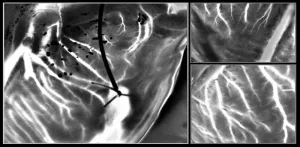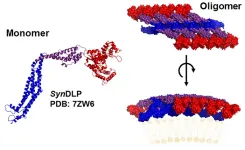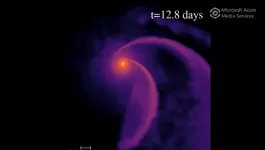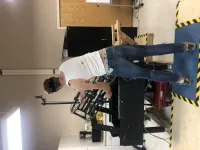(Press-News.org) Researchers from Prof. Steve Sibener's group have captured the first atomic-scale images of tin on niobium during the growth process of the next generation of particle accelerators, Nb3Sn.
The study, published in the Journal of Physical Chemistry C, reveals the potential for greater control over the growth of superconducting Nb3Sn films, which could significantly reduce the cost and size of cryogenic infrastructure required for superconducting technology.
Superconducting accelerator facilities, such as those used for X-ray free-electron laser radiation, rely on niobium superconducting radio frequency (SRF) cavities to generate high-energy beams. However, the associated cryogenic infrastructure, energy consumption, and operating costs of niobium SRF cavities limit access to this technology.
To address this issue, researchers have been working to identify superconducting materials that can operate at temperatures higher than 2 Kelvin with comparable quality factors to niobium (Nb) SRF cavities. One of the most promising materials is triniobium tin (Nb3Sn), an alloy with an operating temperature of 18 Kelvin, thus reducing the need for expensive cryogenic infrastructure.
Despite theoretical and experimental advancements in the performance of Nb3Sn-coated cavities, there is still a need for a thorough understanding of how to grow higher quality Nb3Sn alloy films.
“Nb3Sn cavities are going to be the accelerators of the future,” says Ritchie Patterson, director of the Center for Bright Beams. “Advancing this science is only made possible through diverse collaborations - an important focus at the heart of CBB. The expertise and close collaborations between all of our partner institutions are driving this research into the future.”
This new CBB research, conducted by experimental materials chemists at the University of Chicago coupled with theoretical physicists at the University of Florida, delivers the first atomic-scale images of Sn on oxidized niobium, depicting the early stages of Nb3Sn formation. This visualization of Sn adsorption and diffusion on oxidized niobium is an essential advancement in creating a mechanistic formula for optimizing the fabrication of next generation accelerator cavities.
“The quality and accelerating performance of Nb3Sn depends on many convoluted variables at play during the growth procedure” says Sarah Willson, CBB graduate student at the University of Chicago and co-lead author of the paper along with postdoctoral scholar Rachael Farber. “We are aiming to look at the initial steps of a complicated growth process and isolate certain variables in a controlled setting.” Their atomic-level growth experiments are supported by quantum theory from graduate student Ajinkya Hire.
As Nb3Sn accelerator cavities are prepared, scientists aim to reduce impurities and contaminants from the niobium cavity to achieve a cleaner and more uniform surface. The cavity is then heated to high temperatures in the presence of an Sn vapor. This causes the Sn to diffuse into the Nb layer, forming Nb3Sn. As careful measures are taken to grow a pristine Nb3Sn film, looking closely across the cavity reveals a highly disordered, rough, polycrystalline surface - not the consistent single-crystal surface ideal for a highly controlled experiment.
Willson explains that in order to conduct this experiment, they recreate, in a way, the real-world process of cavity-making, but further surpass the temperature demands needed–heating the materials to 1630 degrees Celsius, and creating an atomically-flat niobium oxide surface to showcase the interactions of Sn, Nb, and O at the atomic level.
Observations of metal oxides are routinely performed using scanning tunneling microscopy, STM, revealing information at the atomic scale. However, the specific setup for studying Nb3Sn growth with STM is not readily available. So, Willson and Farber created one.
They designed and built a custom metal deposition chamber to deposit the Sn on the niobium surface. This technique recreates the real-world environment in which accelerator cavities are developed – with the ability to prevent surface contamination – while allowing researchers to study the deposition using STM.
“We have taken a state-of-the-art STM setup, which was not really built to study high temperature metallic growth and alloy formation, but through the funds from CBB, have added the intermetallic growth chamber that allows us to do these experiments in-situ,” says Willson, stating that using the intermetallic growth section reveals the individual Sn atoms integrating with the niobium subsurface.
“We see that even in our highly-controlled environment, the Nb surface serves as a major roadblock in preventing Sn diffusion required for Nb3Sn formation,” says Willson. “Improving Nb3Sn growth is much more than just simply developing a uniform coating layer of tin on niobium.”
This study was led by Steven Sibener, Carl William Eisendrath Distinguished Service Professor at the University of Chicago, in collaboration with CBB faculty member Richard Hennig, Alumni Professor of Materials Science and Engineering at the University of Florida.
Sibener, a physical chemist, says that the collaboration between different areas of accelerator and non-accelerator sciences is unique in his experience, helping to lay the groundwork for advancing particle accelerators and looks forward to the promising developments of Nb3Sn.
“The collaborations that CBB sparks, the ability for surface chemists, materials engineers, accelerator physicists, and theorists to interact in this way, has certainly empowered and strengthened this research,” says Willson. “Personally, I gained a deeper understanding of how to properly navigate the challenges associated with the differing jargon, priorities, and research perspectives across scientific fields. Many chemists are interested in these types of interfacial metallic growth challenges that are encountered by engineers and physicists. This collaboration facilitated extensive interdisciplinary communication that has made conducting a study like this more comfortable and efficient.”
END
Boston, MA – The Thich Nhat Hanh Center for Mindfulness in Public Health will launch April 26 at the Harvard T.H. Chan School of Public Health. The Center was created with a $25 million gift from an anonymous donor, one of the largest single donations to the School.
The Center’s mission is to empower people around the globe to live with purpose, equanimity, and joy through the practice of mindfulness; pursue evidence-based approaches to improve health and well-being through mindfulness; and educate and train the public in mindfulness. Two primary areas of emphasis will be nutrition and the environment.
“We are thrilled to host this groundbreaking ...
For 30% to 40% of lymphoma patients who receive CAR T therapy, the treatment is a godsend. Typically given to lymphoma patients for whom other treatments have proven ineffective, CAR T therapy involves removing immune cells from the body via a blood draw, reengineering them to become better cancer fighters, then reintroducing them to the bloodstream, where they seek out and destroy cancer cells.
For 60% to 70% of lymphoma patients who receive CAR T therapy, however, the treatment doesn’t work, and the cancer comes back — typically within ...
ARLINGTON, Va., April 25, 2023 — A new clinical guideline from the American Society for Radiation Oncology (ASTRO) and European Society for Radiotherapy & Oncology (ESTRO) provides guidance on the use of definitive local therapy—including radiation and surgery—to treat patients with oligometastatic non-small cell lung cancer (NSCLC). The guideline is published in Practical Radiation Oncology.
The guideline emphasizes the need for a multidisciplinary team approach to guide treatment decisions for oligometastatic disease, a description for cancer that reaches a state in which the patient has a small number of metastases in addition to a primary tumor. ...
Ithaca, NY—What's good for the Black-backed Woodpecker is good for restoration of burned California forests. The birds' unique relationship with fire underpins the latest research into improved post-fire management. A study published in Ecological Applications describes a new tool that factors how fires burn into forest management decisions and turns science into action for wildlife conservation.
"Wildfire is like a 10,000-piece puzzle, and climate change is rearranging the pieces," said lead author Andrew Stillman with the Cornell Atkinson Center for Sustainability and the Cornell Lab of Ornithology. "Gigantic, severe fires ...
Researchers at National Jewish Health found that a subset of children suffering recurring fevers as a result of long COVID-19, benefited from a daily medication treatment commonly used for gout and periodic fever syndrome. Using the drug Colchicine, researchers saw rapid improvement not only in their fevers but also with other long COVID symptoms such as brain fog, fatigue, and achiness. The case study was just published in Journal of Allergy and Clinical Immunology, (JACI: In Practice).
Long COVID is defined as persistent symptoms lasting ...
East Hanover, NJ – April 25, 2023 – New data shows that Hispanics with disabilities in the United States rebounded to historic levels in the labor force following the first 12-month period of the COVID-19 pandemic. While the disparity between their non-Hispanic white counterparts remains, their recovery has narrowed this gap and surpassed that of their black/African American counterparts, according to experts speaking during last Friday’s nTIDE Deeper Dive Lunch & Learn Webinar. To further improve employment opportunities ...
In the majority of cases, graft failure after heart transplantation is attributable to abnormalities like severe coronary artery disease. As donors with extended criteria like advanced age and pre-existing heart conditions become eligible for heart transplantation, careful screening for congenital abnormalities has become crucial. Invasive coronary angiography is an essential screening tool that can detect coronary artery disease (CAD), a condition characterized by cholesterol deposits in the heart's arteries. However, logistical challenges limit utility so it’s used for fewer than a third of donors who are at risk of developing CAD.
To overcome this limitation, a new heart ...
-- JOINT PRESS RELEASE OF FORSCHUNGSZENTRUM JÜLICH AND JOHANNES GUTENBERG UNIVERSITY MAINZ --
SynDLP could be a bacterial ancestor of eukaryotic membrane proteins
The cells of living organisms are equipped with proteins that are involved in the shaping and remodeling of cellular membranes, thereby performing important tasks. The cell membrane encloses the cell interior, but is constantly remodeled, for example, due to membrane budding, invagination, or fusion processes. This also involves various proteins that were long assumed to be present exclusively or predominantly in higher organisms. ...
If they exist, intermediate-mass black holes likely devour wayward stars like a messy toddler — taking a few bites and then flinging the remains across the galaxy — a new Northwestern University-led study has found.
In new 3D computer simulations, astrophysicists modeled black holes of varying masses and then hurled stars (about the size of our sun) past them to see what might happen.
When a star approaches an intermediate-mass black hole, it initially gets caught in the black hole’s orbit, the researchers discovered. After that, the black hole begins its lengthy and violent meal. Every time the star makes a lap, the black hole takes a bite — ...
Dungeness crab fishermen are at high risk for on-the-job injury, but having a metal bar to bang crab pots against as they harvest can help them prevent injury, an Oregon State University study found.
The study sought to determine whether the fishermen-designed “banger bar” actually improves worker safety aboard crab vessels. The metal bar is installed atop the crab-sorting table and makes it easier for fishermen to empty the crab pots they haul up from the ocean floor, but there is no industry standard on whether crabbers install one or how they ...





